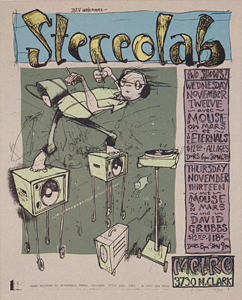This week's announced closing of Borders Bookstores leaves just one remaining major U.S. brick-and-mortar bookseller, Barnes & Noble. Within the past year, one independent (or as their awning states..FIERCELY independent) bookstore in Oak Park, IL, The Book Table, has witnessed the closing of two of its rivals, Borders and Barbara's Bookstore, both within a block of their store. But husband and wife Book Table owners Jason Smith and Rachel Weaver view it as a solemn occasion rather than a cause for celebration. I asked Jason about their business and the outlook for the future of independent bookstores:
Q: How have you managed to survive when others around you have gone under recently?
Jason: I think our biggest strength is that we have two owners that are very involved in the day-to-day operations of the store. One or the other of us is always behind the counter. We're able to respond to customers in ways that other stores aren't and it allows us to be more involved in the community as a whole in a way that chain stores aren't.
Q: You've cosponsored some very interesting guest lecturers at Oak Park's Unity Temple, some of which I've blogged about. How did that series come about and how do you decide who to book and who would you most like to book for an appearance?
Jason: Writers at Wright is a partnership between The Book Table, Friends of the Oak Park Public Library, Unity Temple Restoration Foundation and Midwest Media. We came together because we felt there was a need to bring high quality authors to Oak Park and we thought Unity Temple is a perfect venue for them to showcase their talent. Midwest Media and The Book Table share the responsibility of booking authors. Since it's a partnership, we all need to agree on the various authors. I have a list of my favorite authors and am very excited that one of them, Neal Stephenson, will be at Unity Temple in September. In the world of graphic novels, we're very excited to have Daniel Clowes and Seth coming in October. Art Spiegelman and Craig Thompson are probably the two graphic novelists that I'd most like to have at Unity.
Q: Where do you see the book selling business heading in the next few years?
Jason: The book business is in flux right now and anyone that thinks they know what's going to happen is just pretending. With Borders liquidating, this country is losing 6.2 million square feet of books display space. The big winner will be Amazon and eBooks. I think any industry that is dominated by one company isn't a healthy industry and if that industry is selling ideas then it's even more dangerous.
Q: What do you like best about Oak Park and your Lake Street location?
Jason: We're constantly amazed by the feeling of community in Oak Park. We get to interact with so many amazing people every day at our counter and just walking down the street. We love the impromptu community meetings as people run into each other browsing in our store.
Q: Do you have a personal all-time favorite book or author?
Jason: My list of favorite authors is Haruki Murakami, Richard Powers, Neal Stephenson and David Foster Wallace. Rachel's is John Ashbery, Kazuo Ishiguro, Audre Lorde, Sylvia Plath and Zadie Smith.
Thanks to Jason and Rachel for providing some insight into their livlihood. Please support them and other independent bookstores, which are becoming all too scarce in the current economy. And when you stop in, say "Hi" to Jason and Rachel and let them know you read about them here.












